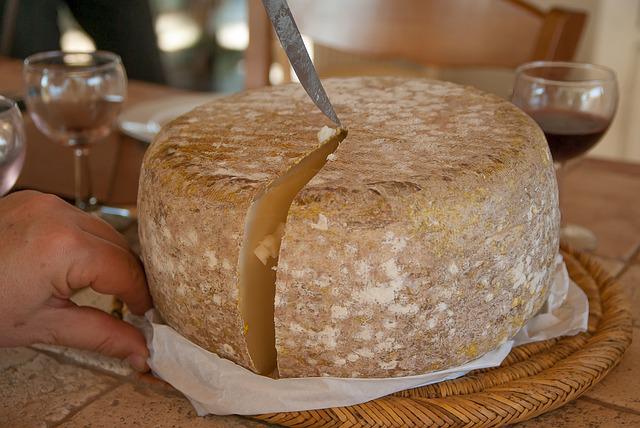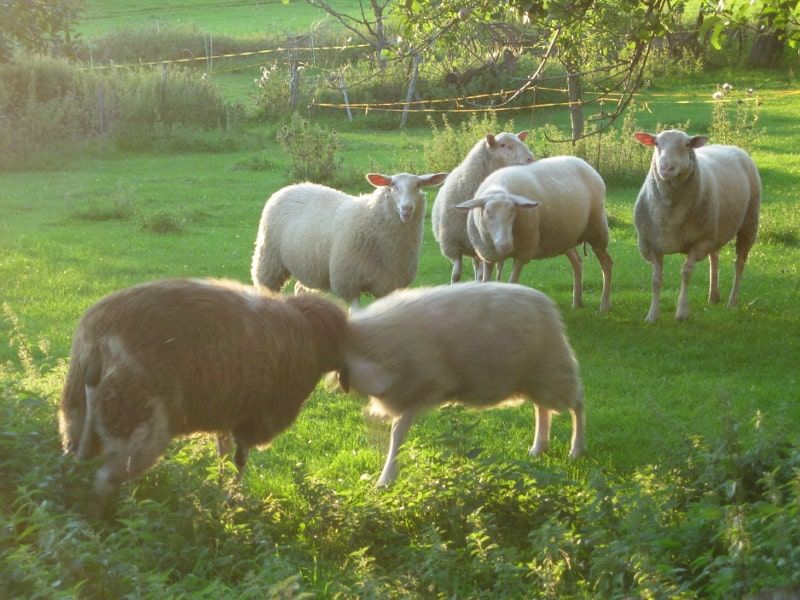Sheep's Milk: Importance, Quality, and Uses
Currently, in several first-world countries (United States, England, Australia, France, Italy, and Spain) sheep's milk products (cheese, yogurt, and ice cream) are in great demand due to their rich flavor and nutritional value.

In many countries, milk from small ruminants is very important. The Mediterranean region accounts for 66 percent of the world's sheep's milk production. Of the ruminants (cows, buffaloes, goats, and sheep), sheep's milk constitutes 1.5 percent of that obtained in the world; the Mediterranean contributes 11.7 percent. In some countries, including Greece, there is one sheep and goat combined per inhabitant and hectare of pasture.
In Central and Eastern Europe, until the late 1980s, sheep were used primarily for wool production and secondarily for meat production. In the early 1990s, due to the crisis in the wool sector, milk was seen as a viable alternative. The attraction lies in the payment of incentives to sheep farming in some countries. In addition, its products are marketed as specialties with the designation of origin.
Asia has 40 percent of the world's sheep population, with a large number of indigenous breeds. Dairy production focuses on self-consumption as fluid milk and a variety of local products. In the Mediterranean area of West Asia and North Africa, the use of milk is through the consumption of cheese and yogurt. Currently, they are concerned with the quality of the product and the grouping of producers to facilitate its commercialization and obtain a better positioning in the market.
In North America, the activity began to develop several decades ago. In the United States and Canada, approximately 50 percent of sheep milk is industrialized on the farm. Most producers freeze the milk for preservation and transportation, although the production of sheep cheese has increased in recent years, the United States is an importer of these products. From a production standpoint, there is a shortage of dairy genetics.
In Mexico, it is difficult to obtain general statistics (number of producers and animals involved) because the sector is focused on the production of mature cheeses (Manchego and Feta types). In South America, countries such as Argentina and Chile began milk production with specialized farms a decade ago. There is a need to integrate production chains and adapt available technologies to local environments and production systems.
Quality of sheep's milk and its comparison with other species

Chemical composition
The importance of sheep's milk in human nutrition in some countries of the world is due to its higher content of fat (50 percent), protein (40 percent), and total solids (30 percent) than cow's milk and almost the same proportion compared to goat's milk.
Lipid content
Sheep's milk contains a large amount of essential, short and medium-chain monounsaturated and polyunsaturated fatty acids, which are considered of value in human health; especially medium-chain fatty acids, such as caprylic (C8:0) and capric (10:0); 20 percent of the fatty acids in sheep's milk are short and medium-chain saturated (C4:0 to C12:0), while cow's milk contains 12 percent. This contributes to the faster digestion of milk. The fat in sheep's milk is in the form of globules with an average diameter of 3.3 microns, which are smaller in size than the globules in cow's milk (4.55 microns). The amount of cholesterol in sheep's milk increases with the amount of fat, which is 150 to 300 mg/liter.
The essential amino acid content
Sheep's milk contains almost twice as many of the 10 essential amino acids as goat's and cattle's milk. While the amount of amino acids in human milk is lower: they range from four to seven times depending on the amino acid. The amino acids found in greater quantities in sheep's milk are isoleucine, leucine, lysine, and valine.
Mineral content
Sheep's milk has higher mineral content. Calcium, phosphorus, and magnesium predominate. Mammalian milk is generally deficient in iron; however, sheep's milk is twice as high as that of other productive domestic animal species. About human milk, the iron content is 3.3 times higher in sheep milk, but it is lower than goat and cow milk in potassium and sodium.
Vitamin content
Sheep's milk is superior in many of the vitamins necessary for human nutrition. Thiamine, riboflavin, and vitamins B6, B12, D, and C stand out. Its folic acid content is similar to that of cow and human milk.

Milk products from sheep milk
Currently, in several first-world countries (United States, England, Australia, France, Italy, and Spain) sheep's milk products (cheese, yogurt, and ice cream) are in great demand due to their rich flavor and nutritional value. The most commercial sheep's milk cheeses are Roquefort, feta, manchego, and pecorino.
Cheeses
Fat and casein are the primary milk components directly related to cheese production. The high casein content (80 percent of total protein) allows for shorter renin coagulation time and firmer curds. Sheep's milk has better coagulation properties and cheese-making potential than cow's milk. The types of casein in sheep's milk are as1, as2, b, k, and g.
The percentage of as1 and as2 is higher in sheep's milk than in goat's milk but lower than in cow's milk. However, casein b represents 50 percent of the total in sheep's milk, while in goat's milk it is 2/3, and in cow's milk 1/3. These variations in casein percentages explain the difference in micelle structure and the absence of bitter taste in sheep's milk cheeses.
Tests carried out in the United States have determined that the yield of each cheese varies from 16.7 to 21.9 percent according to the type of cheese produced; while cow's and goat's milk yields from 7 to 10 percent.
Yogurt
The solids content of sheep's milk provides an option for the production of yogurt with high biological value and easy digestibility. In addition, due to the high total solids content, it does not require the addition of solids or stabilizers. Sheep's milk yogurt has high stability in cold storage. Its price should be competitive with cow's milk yogurt. It can be made low-fat after the separation of the cream, which can be used for butter production.
Ice cream
The production of ice cream with sheep's milk has been tested in Australia with certain market potential. It is even looking for export facilities to Japan. One problem to be solved is to set a competitive price since products made with sheep's milk are usually more expensive than those made with cow's milk. It is a very tasty product and is preferred with a high fat content (10 percent).

Medical and Nutritional Benefits of Sheep Milk
The nutritional quality of sheep's milk lies in its high content of medium-chain fatty acids. The medical literature documents the benefit of these acids in the case of malabsorption syndromes, feeding of premature babies, critical care and malnourished patients, intestinal resection, lithiasis, cystic fibrosis, and cholesterol problems.
Sheep's milk has been proposed as an alternative supplement in pre-and postoperative clinical nutrition to improve recovery of patients' body weight loss and muscle strength. With approximately 500 milliliters of milk, 500 milliliters of yogurt, or 93 grams of cheese, the requirements of calcium, phosphorus, riboflavin, and 8 of the 10 essential amino acids are covered.
The market for sheep's milk products
In Mexico, sheep's milk is a new product on the market with limited demand. It is mainly used in the production of cheese.
Europe is the most technologically advanced region in sheep's milk production; however, there are still challenges for them in the small ruminant dairy sector, the most important of which are: consumer attitudes, the market situation, financial support for rural and agricultural development (subsidies), rural labor issues, competition from other producing areas and with products made from cow's milk. Nevertheless, good prospects are expected for the sector in the European Union, especially if market trends continue.
Milk production as a complementary factor is an attractive investment scheme in the Mexican countryside, with good profitability prospects for small and medium-sized producers. From an economic point of view, it is necessary to consider that sheep produce less milk, as well as a shorter lactation period than goats and cows. However, their wide adaptation to different climates and forages makes sheep a more acceptable animal with great genetic potential.

Breeds for sheep milk production in Mexico
The dairy breed par excellence in Mexico is the East Friesian, with a production of 1.4 to 1.7 liters per day (L/d) with a lactation duration of 200 to 230 days. Non-dairy ewes such as the Rambouillet breed produce 0.820 L/d with a lactation of 90 days. The Rambouillet (3/4) x East Friesian (1/4) cross produces 0.920 L/d with a lactation of 112 days.
Source: Universitarios Potosinos by Manuel Antonio Ochoa Cordero. He holds a Ph.D. in agricultural sciences from the Faculty of Agronomy and Veterinary Sciences of the UASLP and is a professor at the same academic institution.




